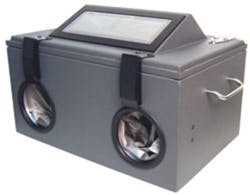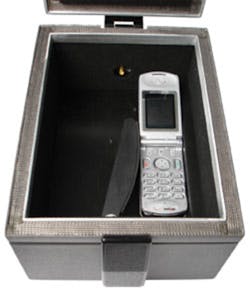Is the traditional screen room of yesterday the compact RF test enclosure of today?
With all the new wireless devices operating in the over-populated frequency bands from 30 MHz to >6 GHz, it has become impossible to test, tune, or verify any product without the capability to shield it from the outside world. And as demand for these products continues to escalate, providing an RF-isolated testing environment while keeping production costs in line is a daunting task.
The Original Solution
The basic requirements for an RF isolated test area are simple: If the DUT is a transmitter, then it must be isolated, preventing free-air radiation that could be harmful or transmitting radiation to disrupt on-air traffic. If a receiver, then it must be isolated from on-air signals that could interfere with accurate testing. This dates back to the early pager days when it became extremely difficult to align a pager receiver while the front end was being swamped with high-power, continuous on-air traffic.
When engineers traditionally envisioned an RF-tight isolation environment, the screen room usually was the first entity that came to mind. These screen rooms were large enough for the technician, the bench, and all the equipment. Used for years, these high-dollar rooms always required a large area and custom installation, not to mention the highly detailed and frequent maintenance and measurement procedures to ensure proper RF isolation.
Mass Production Obviates Traditional Means
The sheer quantity of devices to be tested today and the required detailed test procedures prevent the use of the typical screen-room application. Beyond that, the safety of the technician within such an environment requires an alternate solution.
A novel approach to the screen-room alternative appeared with the development of the RF shielded test enclosure. First showing up in the 1980s, these test enclosures, simply put, place a miniature screen room on the technician�s bench, allowing the DUT to be placed inside for the required test.
The overall RF shielding concept was the same as a traditional screen room; there needed to be an extremely tight RF isolation from the outside world. This typically ranged from 50 dB to >100 dB depending on the frequency range. However, the commonality stops there.
Without having the technician and his test equipment inside the screen room, suitable I/Os in the form of RF, power, and data connectors had to be provided to interconnect to the DUT. However, with all connectors comes the likelihood of RF leakage, so extreme care had to be taken to filter all connections in and out of the enclosure. And without being inside the screen room, hands-on manipulation, adjustment, and tuning of the DUT are impossible.
Also important to the wireless market is the capability to provide flawless go, no-go testing with absolute repeatability. Often a golden transmitter or receiver of known specifications will be used in one enclosure while a programmable attenuator is used in series with a second enclosure to provide a power-level-agile system for performance testing.
Another popular procedure includes an enclosure with a built-in radiating test fixture that not only provides direct RF coupling to the DUT, but also secures it in a fixed, repeatable location and position within the box. Knowing the coupling factor involved together with the specifications of the golden DUT, quick go, no-go testing can be achieved.
Solving the Problem
The problem of providing an isolated RF test environment became paramount for the Nortel Networks wireless lab facilities in Richardson, TX. In July 2002, Nortel began researching the possibility of using small desktop-style RF shielded enclosures as a more cost-effective means of providing isolated testing and reducing the demand on RF shielded rooms. The requirements were complex:
� Have the capability to manipulate a mobile phone under test in a sealed RF environment.
� Interface signals to test equipment outside of the environment.
� Maintain a suitable isolation across the entire operating frequency band.
� Ensure zero ambient interference from the DUT.
� Maintain operator safety from the DUT.
Nortel turned to Ramsey Electronics, a manufacturer of benchtop RF shielded test enclosures for many years. Ramsey�s STE3000B Enclosure was the base for Nortel�s application (Figure 1). This enclosure features an RF-tight, illuminated viewing window and provides hands-on access to the DUT through a set of RF shielded gloves.
Figure 1.
STE3000B RF Shielded Enclosure
The enclosure had to provide greater than 90-dB isolation over Nortel�s dual-band operating ranges of 800 MHz and 1,900 MHz. Standard Type-N RF feed-through connectors and properly RF-filtered data interface connectors were required. All interior walls of the enclosure were lined with -24-dB absorbent foam to reduce RF nulls and hotspots.
RF Safety and Spectrum Interference Concerns
To meet the RF interference and safety issues, Nortel worked with Ramsey to develop a custom RF Safety Inhibit. The enclosure has three antennas connected internally through relay switches to the RF bulkhead. In addition, a reed switch is located near the lid to sense whether the lid is opened or closed. When the lid is closed, the reed switch activates the relays to allow transmission through the antennas. When the lid is opened, the reed switch senses this and forces the relays to terminate the transmission to a load on each of the relays (Figure 2).
Figure 2. Enclosure With Three RF Safety Inhibits
It�s a Wireless World Out There
Today, the need for efficient RF isolated testing extends well beyond the wireless market. Likewise, the development of suitable RF shielded test enclosures has had to follow.
From the early 802.11(b) protocol, the wireless LAN technologies have dramatically changed. What was previously a small plug-in PCMCIA laptop adapter that could easily be tested in a small enclosure now has become an embedded function using multiple frequencies in most laptops.
With this comes the necessity to test an entire laptop within an enclosure. On the opposite side, repeaters, extenders, and other large and small distribution products require an RF-tight testing environment.
Conclusions
As the uses of wireless devices continue to grow, so will the need for an efficient test environment. Whether cellular/PCS, GSM, RFID, Bluetooth�, or the growing family of wireless LAN access point and test products, it is certain that RF-safe and interference-free isolation test chambers will be required not only for design and development but also for product testing.
About the Author
James D. Agostinelli, director of sales and marketing at Ramsey Electronics, has more than 15 years of experience in wireless marketing, product, and systems development. He holds a B.S. and an M.B.A. from Rochester Institute of Technology. Ramsey Electronics, 590 Fishers Station Dr., Victor, NY 14564, 800-446-2295, e-mail: [email protected]
FOR MORE INFORMATION
on RF test enclosures
www.rsleads.com/604ee-197
April 2006


